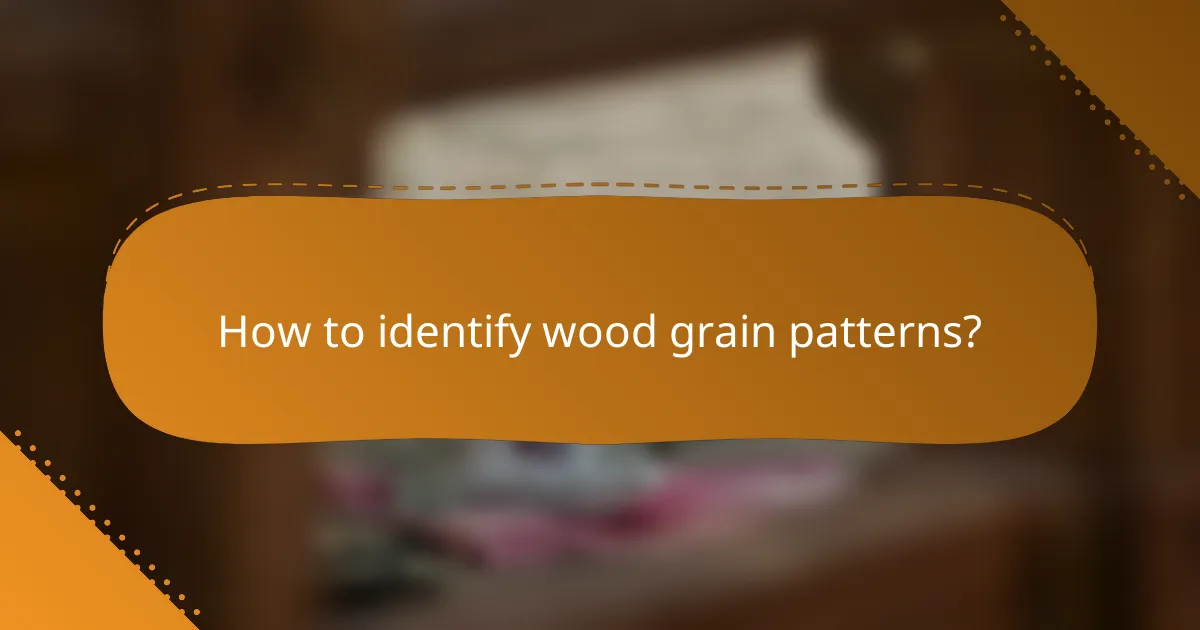Wood grain techniques are essential for identifying, enhancing, and applying the natural beauty of wood in various projects. By observing unique textures and lines, one can determine the type of wood and its potential applications. Enhancing wood grain through staining and finishing can significantly elevate its visual appeal, while a structured approach ensures effective application and optimal results.

How to identify wood grain patterns?
Identifying wood grain patterns involves observing the unique textures and lines on the surface of the wood. These patterns can indicate the type of wood and its potential uses in projects.
Common wood grain types
There are several common wood grain types, including straight, wavy, and interlocked. Straight grain is characterized by parallel lines, often found in softwoods like pine. Wavy grain, seen in woods like cherry, features undulating patterns, while interlocked grain, typical of mahogany, exhibits a crisscross appearance.
Understanding these types helps in selecting the right wood for specific applications, such as furniture making or cabinetry. Each grain type not only affects aesthetics but also influences the wood’s strength and workability.
Tools for wood grain identification
To identify wood grain patterns effectively, several tools can be useful. A magnifying glass can help reveal finer details in the grain structure, while a moisture meter can indicate the wood’s density, which often correlates with grain type.
Additionally, wood identification guides or apps can assist in matching observed patterns with known species. Having a basic understanding of these tools can streamline the identification process, especially for hobbyists and professionals alike.
Visual characteristics of wood grains
Wood grains exhibit distinct visual characteristics that can aid in identification. The color, texture, and pattern of the grain can vary significantly between species. For example, oak typically has a prominent open grain with a coarse texture, while maple features a smoother, closed grain.
Light can also affect how grain patterns are perceived; for instance, direct sunlight may highlight the grain’s depth and color variations. Observing these characteristics closely can provide valuable insights into the wood’s identity and suitability for various projects.

What techniques enhance wood grain appearance?
Techniques that enhance wood grain appearance include staining, finishing, and using specific products designed for wood enhancement. These methods can significantly improve the visual appeal of wood by highlighting its natural patterns and colors.
Staining methods for wood enhancement
Staining is a popular technique for enhancing wood grain by adding color while allowing the natural texture to show through. Common types of stains include oil-based, water-based, and gel stains, each offering different levels of penetration and finish. Oil-based stains typically provide richer colors and longer drying times, while water-based stains dry quickly and are easier to clean up.
When applying stain, consider using a pre-stain conditioner to ensure even absorption, especially with softwoods like pine. Test the stain on a scrap piece of wood to gauge the final color before committing to the entire project.
Finishing techniques for wood grain
Finishing techniques protect the wood while enhancing its grain. Common finishes include varnish, polyurethane, and lacquer, each offering varying levels of durability and sheen. For example, polyurethane provides a tough, water-resistant finish, making it ideal for high-traffic areas.
To achieve the best results, apply multiple thin coats of finish, sanding lightly between each coat to ensure smoothness and clarity. Be mindful of the drying times and environmental conditions, as humidity and temperature can affect the finish quality.
Best products for wood grain enhancement
Choosing the right products for wood grain enhancement can make a significant difference in the final appearance. Look for high-quality stains and finishes from reputable brands that are known for their durability and ease of application. Popular options include Minwax for stains and Varathane for finishes.
Additionally, consider using wood grain enhancers or sealers that specifically highlight the grain pattern, such as a grain filler for open-pored woods. Always read product labels for compatibility with your wood type and follow the manufacturer’s instructions for the best results.

How to apply wood grain techniques effectively?
Applying wood grain techniques effectively involves understanding the type of wood, selecting appropriate methods, and using the right tools. By following a structured approach, you can enhance the natural beauty of the wood while achieving the desired aesthetic.
Step-by-step application process
Start by preparing the wood surface, ensuring it is clean and smooth. Sand the wood with fine-grit sandpaper to remove any imperfections and create a suitable base for the grain technique.
Next, choose your wood grain technique, such as faux grain, staining, or glazing. Apply the chosen method using a brush, sponge, or cloth, depending on the effect you want to achieve. Allow the finish to dry thoroughly before applying additional coats if necessary.
Finally, seal the wood with a protective finish like polyurethane or varnish to enhance durability and maintain the appearance of the wood grain.
Common mistakes to avoid
Avoid skipping surface preparation, as this can lead to uneven application and poor adhesion of the finish. Always ensure the wood is clean and sanded properly before starting.
Another common mistake is using the wrong tools for application. For example, using a brush when a sponge would create a better effect can result in unsatisfactory results. Always choose tools that suit the specific technique you are applying.
Lastly, be cautious with drying times. Rushing to apply additional coats before the previous layer has dried can cause smudging and uneven finishes.
Recommended tools for application
Essential tools for applying wood grain techniques include high-quality brushes, sponges, and rags. A foam roller can also be useful for larger surfaces, providing a smooth finish.
For staining or glazing, consider using a wood grain tool or comb to create realistic patterns. A fine-grit sandpaper is crucial for surface preparation, while a clean cloth is necessary for wiping off excess stain or finish.
Lastly, a good quality sealant, such as polyurethane, is recommended to protect the wood and enhance its appearance after application.

What are the best wood types for showcasing grain?
The best wood types for showcasing grain are those with distinct patterns and textures that enhance visual appeal. Hardwoods generally offer more pronounced grain features, while some softwoods also present unique characteristics worth considering.
Hardwoods with prominent grain
Hardwoods like oak, walnut, and cherry are renowned for their striking grain patterns. Oak features prominent rays and flecks, while walnut showcases rich, dark hues with intricate swirls. Cherry develops a beautiful patina over time, enhancing its natural grain.
When selecting hardwoods, consider the intended application. For furniture, oak and cherry provide durability alongside aesthetic appeal, while walnut is often favored for high-end cabinetry and decorative pieces.
Softwoods and their grain characteristics
Softwoods such as pine, cedar, and fir can also exhibit interesting grain patterns, though they tend to be less pronounced than hardwoods. Pine often displays knots and a straight grain, making it ideal for rustic designs. Cedar is valued for its aromatic properties and natural resistance to decay, with a fine, even grain.
When working with softwoods, be mindful of their susceptibility to dents and scratches. They are often more affordable and easier to work with, making them suitable for projects where cost and ease of handling are priorities.
Regional wood varieties in North America
North America boasts a variety of regional wood species that highlight unique grain characteristics. Maple, particularly sugar maple, is known for its fine, uniform grain and is popular for cabinetry and flooring. Birch offers a smooth texture with subtle grain patterns, often used in furniture making.
Consider local availability when choosing wood types. Using regional varieties not only supports local economies but also ensures that the wood is acclimated to the environment, reducing the risk of warping or cracking over time.

How do environmental factors affect wood grain?
Environmental factors significantly influence wood grain by affecting its moisture content and overall stability. Humidity and temperature fluctuations can lead to changes in the appearance and texture of wood, impacting both its aesthetic qualities and structural integrity.
Impact of humidity on wood grain
Humidity plays a crucial role in the behavior of wood grain. High humidity can cause wood to absorb moisture, leading to swelling and potential warping, while low humidity can result in shrinkage and cracking. It’s essential to maintain a stable environment to preserve the wood’s appearance and prevent damage.
When working with wood, aim to keep relative humidity levels between 30% and 50% for optimal performance. Using a hygrometer can help monitor these levels, ensuring that wood remains in good condition during storage and application.
Temperature effects on wood finishing
Temperature affects the application and curing of wood finishes. Ideal temperatures for finishing wood typically range from 15°C to 30°C (59°F to 86°F). At lower temperatures, finishes may take longer to dry, while higher temperatures can cause them to dry too quickly, leading to uneven application.
For best results, avoid applying finishes in extreme temperatures. If conditions are outside the ideal range, consider adjusting your workspace or using heat sources to create a more suitable environment for finishing tasks.

What are the latest trends in wood grain techniques?
The latest trends in wood grain techniques focus on sustainability, innovative finishes, and contemporary design aesthetics. These advancements not only enhance the visual appeal of wood but also promote environmentally friendly practices in woodworking.
Sustainable wood grain products
Sustainable wood grain products are gaining popularity as consumers become more environmentally conscious. These products often use reclaimed wood or timber sourced from responsibly managed forests, ensuring minimal impact on ecosystems.
When selecting sustainable options, look for certifications like FSC (Forest Stewardship Council) or PEFC (Programme for the Endorsement of Forest Certification). These labels indicate that the wood has been harvested in a way that supports ecological balance and social responsibility.
Innovative finishing technologies
Innovative finishing technologies are transforming how wood grain is enhanced and protected. Techniques such as UV curing and water-based finishes offer durability while minimizing harmful emissions, making them safer for both users and the environment.
Consider using finishes that highlight the natural grain patterns, such as matte or satin sheens, which can enhance the wood’s character without overwhelming it. Experimenting with different application methods, like spraying or brushing, can also yield unique results.
Emerging design trends in woodworking
Emerging design trends in woodworking emphasize a blend of modern aesthetics with traditional craftsmanship. Minimalist designs that showcase the wood’s natural beauty are particularly popular, often featuring clean lines and open spaces.
Incorporating mixed materials, such as metal or glass alongside wood, can create striking contrasts that enhance the overall design. Additionally, custom pieces tailored to individual preferences are increasingly sought after, allowing for personalized expressions in home decor.


